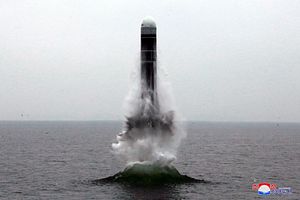On Thursday, North Korean state media announced that Wednesday’s test of a ballistic missile involved the Pukguksong-3, a “new type” submarine-launched ballistic missile. The test took place in the waters off Wonsan, off North Korea’s east coast.
According to South Korean authorities, the missile flew to an apogee of 910 kilometers, flying to a range of 450 kilometers. It flew on a southeasterly trajectory, landing in Japan’s exclusive economic zone off Shimane prefecture. If launched on a normal trajectory, the missile would have a maximum range capability of some 1,900 kilometers—enough to range all of South Korea and all of Japan’s four main islands from the center of the Sea of Japan.
“The test-firing scientifically and technically confirmed the key tactical and technical indexes of the newly-designed ballistic missile and had no adverse impact on the security of neighboring countries,” the Korean Central News Agency, North Korea’s outward-facing state media, reported.
In a notable first, North Korean leader Kim Jong Un was not present at the launch. Instead he conveyed “warm congratulations on behalf of the Central Committee of the [Workers’ Party of Korea]” to the officials involved in the launch. Kim has been present at the inaugural test-firing of every new strategic ballistic missile under his leadership tenure.
Kim’s absence could be an attempt to underplay the significance of this launch as diplomacy with the United States remains underway. U.S. President Donald J. Trump had not commented on the missile test at the time of this writing, but Trump waved aside Kim’s spate of 11 missile tests between May and September, describing his new suite of short-range missile systems as “very standard.”
From released imagery, the Pukguksong-3 appears to be an evolutionary, second-generation SLBM design. It is a two-stage missile with a reentry body shroud. It appears to use solid fuel for propulsion though it is not clear if the missile’s booster is distinct from the Pukguksong-1 SLBM it succeeds. (Another missile in the Pukguksong series, the Pukguksong-2, is a land-based, medium-range variant of the Pukguksong-1.)
In released images, it is clear that the launch of this SLBM took place from under the water. North Korea, however, did not use a submarine in this test. It used an unseen underwater launch platform. In one image, a nearby ship—possibly a towing vessel for the platform—is seen. In the development of a new SLBM, this sort of a practice for an initial engine-burn test is normal: it allows for the testing of the engine without risking a submarine.
North Korea still has one seaworthy ballistic missile submarine, the Gorae, which remains berthed at the Sinpo Shipyard. Another submarine—apparently based on a modification of one of Pyongyang’s older Romeo-class diesel-electric submarines—was revealed earlier this summer to be undergoing refurbishment and modification to serve a ballistic missile launch role.
The introduction and launch of the Pukguksong-3 suggests that North Korea very much remains committed to the sea-leg of its nuclear forces. These capabilities are not a prestige project, but a real investment, seen to confer survivability benefits beyond what can be achieved by road-mobile missiles on land alone.
In a conflict, the United States, South Korea, and Japan would have to contend with North Korean submarines carrying ballistic missiles with nuclear warheads. While anti-submarine warfare capabilities between the three countries are robust and North Korea’s known submarine designs are obsolete, Pyongyang can create additional sources of risk during wartime.
Moreover, submarine-launched missile trajectories could pose problems for missile defenses in both South Korea and Japan. A North Korean ballistic missile submarine in the middle of the Sea of Japan could fire outside of the angle of the South Korea-based Terminal High Altitude Area Defense missile defense system’s AN/TPY-2 radar’s coverage, for example.
In the KCNA release on the test, North Korea described the Pukguksong-3’s utility in defensive terms—perhaps an attempt to underplay the significance of the test with working-level talks with the United States slated to resume on Friday.
“The successful new-type SLBM test-firing comes to be of great significance as it ushered in a new phase in containing the outside forces’ threat to the DPRK and further bolstering its military muscle for self-defense,” the Korean Central News Agency noted.
Wednesday’s launch of the Pukguksong-3 marks the test of the longest-range-capable solid fuel missile ever seen in North Korea. It also marks the first test of a missile unambiguously designed to carry a nuclear payload since the November 28, 2017, test launch of the Hwasong-15 intercontinental-range ballistic missile.
On April 20, 2018, Kim Jong Un publicly declared a moratorium on all intercontinental-range ballistic missile testing and nuclear weapons testing. That moratorium did not extend to submarine-launched ballistic missiles. The launch of the Pukguksong-3 is the first North Korea SLBM test since the August 24, 2016, test of the Pukguksong-1.
The Pukguksong-3’s existence was first revealed in a single image released by North Korean state media in August 2017, during a visit by Kim Jong Un to a facility known as the Chemical Materials Institute. Schematics for the missile were visible on a poster at the facility.

































